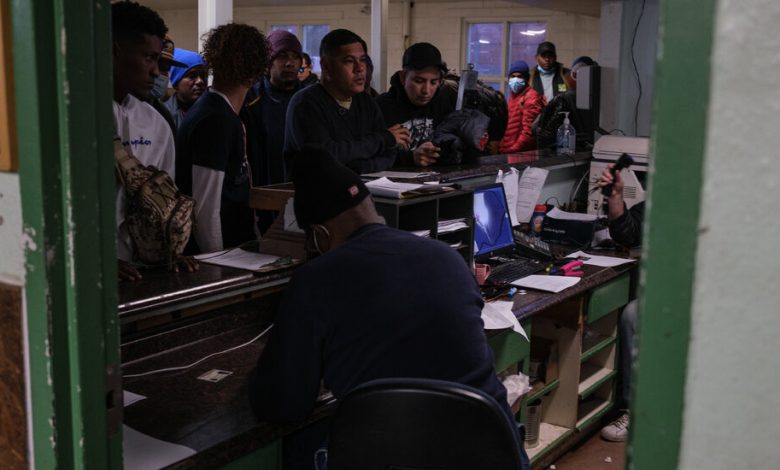El Paso, Long an Immigrant Haven, Is Tested by Spike in Arrivals

EL PASO — From providing refuge during the Mexican Revolution to sheltering asylum seekers during the Trump administration, El Paso has long rolled out the welcome mat to migrants following their star to the United States.
But as migrant arrivals surge this month, becoming so overwhelming that some border crossers are sleeping on downtown streets as temperatures dip below freezing, El Paso’s historic hospitality may finally be wearing thin.
“You feel bad, because they are good people, running away from troubled countries,” said José Cruz, 75, himself an immigrant who came to El Paso from Mexico in 1998. Standing across from the international bridge downtown, Mr. Cruz shook his head in disbelief. “But this city, this country, can’t absorb everybody.”
For many like Mr. Cruz, the crisis is arousing a mix of emotions, reflecting how the pressures of receiving so many newcomers at once are straining a haven sometimes described as the Southwest’s Ellis Island.
The Border Patrol said that, over the weekend, an average of 2,460 migrants arrived each day in El Paso, with the city currently the busiest arrival point for unauthorized migration along the entire southern border.
The number could escalate even further next week if the federal government lifts a public health order that has allowed it to expel large numbers of migrants who otherwise might have been allowed to seek asylum in the United States. At that point, total arrivals across the southern border could reach 12,000 a day, from a recent average of about 8,000, administration officials said.
Alejandro N. Mayorkas, the secretary of homeland security, met in El Paso on Tuesday with Border Patrol managers and local officials amid the escalating arrivals.
“It’s an extraordinarily powerful picture of why we need our immigration system reformed through legislation,” Mr. Mayorkas said in a meeting with local reporters. “Our asylum system is broken. Our immigration system as a whole is broken.”
He said the government was considering an expansion of the program that currently allows Ukrainians and Venezuelans to “prequalify” for asylum processing and enter the United States by plane, rather than by taking a hazardous trip across the border aided by smugglers.
On the streets of El Paso, the escalation in migration has been visible everywhere. Groups of migrants stood outside a shelter that had no more room. At night, many of the arrivals were huddled on the sidewalks and in alleyways under blankets and coats, trying to keep warm. Some have been wandering through the city with seemingly no place to go.
More on U.S. Immigration
- Tech Workers: As cutbacks batter the tech industry, some foreigners on work visas are facing a daunting prospect: having to leave the United States unless they are hired within 60 days of being laid off.
- Texas: Officials in the state took steps to all but close an international crossing in El Paso, which has become a main destination for immigrants seeking to enter the United States.
- Title 42: The Biden administration appealed a court order to rescind a pandemic-era policy that has allowed it to quickly expel new migrants. But an official said the administration still planned to lift the policy.
- Waiting for Refugee Status: As the Biden administration prioritizes resettling people fleeing Ukraine and Afghanistan, many other refugees are waiting years in a system struggling to rebuild.
With few local options, the city may have to resume busing migrants to other cities around the country, said Laura Cruz-Acosta, a spokeswoman for the city, where immigrants already make up about a quarter of the population.
During an earlier surge that began in August, El Paso sent 294 buses of migrants to cities like New York and Chicago.
“We remain hospitable, which is part of our character and part of our nature,” Ms. Cruz-Acosta said. “But the majority of the migrants coming through our community since 2018 don’t have El Paso as their final destination.”
When it comes to dealing with the increase in migrant arrivals, authorities in El Paso, a longtime Democratic bastion, have taken a different tack from other parts of Texas along the border.
El Paso County is not among the dozens of Texas counties that signed on to Gov. Greg Abbott’s declaration of a disaster along the border, eschewing the kind of law-enforcement-focused approach that the state has favored.
The border in El Paso has all of the federal infrastructure that exists in other areas, but it does not have the same deployment of state police officers and National Guard members along the border sent as part of Mr. Abbott’s border mission, known as Operation Lone Star.
The city has not taken part in the state’s program of arresting migrants for criminal trespassing on private ranch land, as several other Texas counties do, and it did not participate in the state’s busing program.
Instead, the Democratic leaders of El Paso created their own busing program, which they could restart soon. It sent roughly the same number of migrants — about 14,000 — to cities north and east of Texas as Mr. Abbott did with his statewide program between August and October.
By contrast, farther east along the border, the city of Eagle Pass in Maverick County — also a Democratic-run part of the state — has been a more willing participant in Mr. Abbott’s efforts.
Officials there, predominantly Democrats, have complained of the strain of providing services to migrants and have welcomed the financial support Mr. Abbott’s program affords for law enforcement.
Despite such contrasts, Annunciation House, an El Paso nonprofit which provides shelter to migrants, began sending busloads this week to places like Kansas City, Mo., and Omaha.
Ruben Garcia, the organization’s director, said he viewed the need to send migrants to other cities through a humanitarian lens.
“El Pasoans don’t want people on the street primarily and overwhelmingly because they’re human beings,” Mr. Garcia said. “There might be other cities where people don’t want refugees on the street because they ruin the landscape.”
Still, Mr. Garcia lamented El Paso’s preparedness for this crisis compared with previous influxes. A declining number of volunteers has depleted the capacity of shelters in the city even as the demand for their services has escalated, he said.
“The volunteers were largely older people who were retired, and elderly people were the most affected by the pandemic,” Mr. Garcia said. “The number of local churches open to receiving refugees has gone down considerably.”
As the Border Patrol has released a larger-than-normal number of migrants in recent days, most of them from Nicaragua, Venezuela and Cuba, the influx is the only talk of the town in El Paso. It is especially inescapable in the stores downtown that cater to the new migrants, selling everything from lowrider apparel to discounted toys.
Edgar Monzón, an El Paso resident for three years and counting, said he recognized a bit of himself in the migrants taking their first steps in the United States after an ordeal.
About 17 years ago, he, too, crossed illegally and made his way to California, before moving to El Paso to be closer to his parents. Now he makes a living as a cabdriver, sometimes picking up migrants who come from Guatemala, as he did.
“What do I tell them? Nothing — good luck,” said Mr. Monzón, 33. “I know what they are going through because I was one of them once. I assume the government knows what they are doing because they are letting them through.”
But for some business owners, including Sunny Butler, who owns Sunny’s Accessories in downtown El Paso, the constant flow of migrants has fueled concerns.
It is hard to admit such feelings, Ms. Butler said, because “they are human and we feel for them and many are women with children.” She wondered aloud whether El Paso needed to reconsider its approach.
“I do get nervous. One side of me says, ‘I want to help,’ but the other side says, ‘I’m nervous,’” Ms. Butler said. “There are just too many people crossing right now. I’ve never seen so many migrants here.”
El Paso’s history with migrants on the border has not always been so welcoming.
Mexican border crossers during the early 20th century were doused with toxic chemicals, ostensibly to delouse them; outrage over the practice in El Paso incited the Bath Riots in 1917, which had to be quelled by U.S. troops.
During the Great Depression in the 1930s, El Paso figured among cities around the United States that together rounded up and deported more than 1 million people of Mexican descent, many of them American citizens.
With the recent escalation in arrivals, including of a group of around 1,000 people who arrived over the weekend in one of the largest single crossings in the city, Gerardo Garcia, who runs the cash register at an eatery downtown, said he could see from his corner of the city that local officials can’t keep up.
He’s begun to notice more people sleeping on the streets in the last year because the shelters are full. Some come to the modest restaurant, hungry and tired, but unable to afford to pay $3 for a gordita.
He said he could not even begin to imagine what will happen if no court intervenes and the pandemic-era expulsion policy, known as Title 42, expires as scheduled on Dec. 21.
“The city can’t keep up with the flow,” said Mr. Garcia, 54. “It’s a crisis now, really. No one has seen anything like it. Everyone is nervous. What if this is only the beginning?”
Eileen Sullivan contributed reporting.





